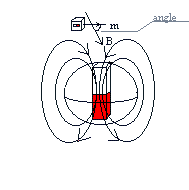|
|
Attitude
control Munin Attitude Control Subsystem (ACS) Passive magnetic attitude control is
ideal for Munin since the main instrument (MEDUSA) then will have fixed aperture
angles relative to the magnetic field. Each aperture will have its own
dedicated pitch angle range. Magnets have been used many times before, e.g.
in the AMSAT microsatellites. Magnets are simple and cost-, mass- and volume
effective. Munin will be affected by torques from
different sources. The mass and size of a satellite decides which torque will
be the dominant one and affect the satellite more than others. In Munin’Äôs
case the magnetic torque generated by the Earths magnetic field tends to be
the most dominating.
Magnetic Stabilization When the satellite is in orbit there will
be disturbances from an external magnetic field, the Earths magnetic field.
The direction of the field is well known at low altitudes and is in the most
northern parts of the Earth downwards (towards the Earth). If the satellite
would have some magnetic properties, it could align itself in the direction
of the field. How magnets interact is well know but the
science behind it might not be as clear. In any case the magnets have the
ability to repel or attract each other. When the magnets have the same pole
towards each other they repel and when they have the opposite poles they
attract. If one would think of the Earth as an giant bar magnet, then a
another bar magnet, attached to Munin, would try to point towards the
direction of the opposite pole of the Earth, thus creating a torque on the
satellite. An advantage of using the magnetic solution
is that there are no moving parts for the ACS. The disadvantage is that the
solution is less effective at higher orbits. Libration Damping
The main reason for the oscillations
(librations) of Munin is the initial separation forces and the Earths
magnetic field. The field lines are directed outwards from the magnetic north
pole and into the magnetic south pole. On its travel around the Earth Munin
will be spinning two revolutions every orbit. Munin will be using a set of six hysteresis
rods for libration damping. The main reason for choosing such a type of
damper is because it have been successfully used before and will not take up
too much space, and it is simple and low cost. More information about attitude control
systems can be found at: SAPPHIRE
ADC SUBSYSTEM |

